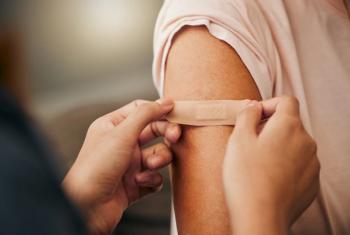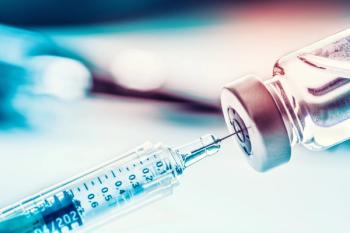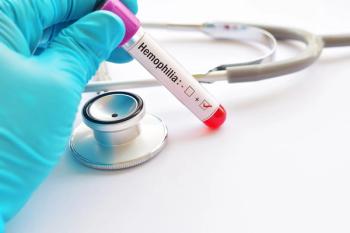
Albuterol-budesonide yields lower asthma exacerbation risk vs albuterol alone
Albuterol-budesonide (Airsupra; AstraZeneca) resulted in a 47% reduction in severe exacerbations in mild asthma vs albuterol alone.
As-needed treatment with albuterol-budesonide (Airsupra; AstraZeneca) in patients with mild asthma aged 12 years and older demonstrated a 47% reduction in severe exacerbation risk compared to albuterol alone, according to new data published in The New England Journal of Medicine (NEJM) and presented at the American Thoracic Society International Conference in San Francisco, California.1
According to the NEJM study authors, mild asthma affects between 50% to 70% of patients diagnosed with asthma, and is often assumed to be low risk. Still, severe or fatal exacerbations occur in people with infrequent asthma symptoms, with up to 30% of exacerbations and deaths reported among patients treated for mild asthma or who have infrequent symptoms.2
"During periods of asthma worsening, patients often rely on their short-acting β2-agonist (SABA) rescue therapy alone, which does not address airway inflammation, thus increasing the risk of severe or fatal exacerbations," wrote the investigators, led by Craig LaForce, MD, of North Carolina Clinical Research, Raleigh, North Carolina. The authors referenced a retrospective study that suggested a "window of opportunity" could exist to prevent a severe exacerbation among patients who have uncontrolled disease, despite treatment for mild asthma.
"In line with this concept and recommendations from the Global Initiative for Asthma (GINA), the combination of albuterol and budesonide in a single pressurized metered-dose inhaler allows patients to receive an inhaled glucocorticoid when they need it by using their rescue therapy in response to symptoms," wrote the investigative team. "In the trial, we investigated the benefit of adding budesonide to albuterol to reduce the risk of a severe asthma exacerbation."
BATURA trial data
According to a press release from AstraZeneca, the anti-inflammatory reliever rescue therapy was evaluated in the phase 3b BATURA trial (NCT05505734), a US-based, multicenter, randomized, double-blind, parallel-group and event-driven trial. The decentralized superiority trial compared as-needed use of 180 μg of albuterol and 160 μg of budesonide with as-needed use of 180 μg of albuterol for a minimum of 12 weeks and a maximum of 52 weeks.1,2
According to study details published in NEJM, eligible participants were aged 12 years and older who had uncontrolled asthma while taking National Asthma Education and Prevention Program Step 1 or Step 2 treatment (defined as either as-needed SABA only or as-needed SABA plus maintenance low-dose inhaled glucocorticoid or leukotriene-receptor antagonist).2
The primary outcome of the trial was severe asthma exacerbation, assessed in a time-to-event analysis in the on-treatment efficacy population. Additionally, a key secondary outcome was the first severe exacerbation, assessed in a time-to-event analysis, in the intention-to-treat population. A severe exacerbation was defined as the worsening of symptoms leading to at least 3 days' use of a systemic glucocorticoid, an emergency department or urgent care visit for asthma that warranted systemic glucocorticoids, hospitalization due to asthma, or death, with documentation. Other endpoints included annualized rate of severe asthma exacerbations and annualized total exposure to systemic glucocorticoids.
In all, there were 2516 participants that underwent randomization, of which 71.4% completed the trial. There were 2421 participants in the full analysis population, of which 1209 were assigned to the albuterol-budesonide group and 1212 to the albuterol group. Most participants (97.2%) were 18 years of age and older and 74.4% used a SABA alone at baseline.
A severe exacerbation occurred in 5.1% of participants in the albuterol–budesonide group and in 9.1% of the albuterol group in the on-treatment efficacy population (hazard ratio, 0.53; 95% confidence interval [CI], 0.39 to 0.73). In the intention-to-treat population, 5.3% of participants in the albuterol–budesonide group had a severe exacerbation compared to 9.4% of participants in the albuterol group, respectively (hazard ratio, 0.54; 95% CI, 0.40 to 0.73) [P < 0.001 for both comparisons]).2 Results demonstrated a 47% reduced risk of a severe exacerbation for albuterol–budesonide treatment vs albuterol treatment alone.1
"For decades, millions of patients have relied on albuterol-only rescue treatment in asthma, leaving them unprotected against the increasing airway inflammation that could lead to a more serious attack," said LaForce in a statement via AstraZeneca's press release. "The results from the BATURA trial add to a wide body of evidence on the value of the anti-inflammatory reliever rescue approach to not only provide immediate relief from symptoms, but also reduce inflammation to prevent future and more severe exacerbations for patients living with asthma across all severities.”
Exposure to systemic corticosteroids
The trial revealed that adults and adolescents aged 12 years and older who received albuterol–budesonide had 63% lower exposure to total systemic corticosteroids (SCS) across the treatment period vs those who received albuterol alone (P < 0.001). This lower exposure in turn reduced known risks from cumulative exposure to SCS, which are commonly used to control inflammation in asthma and to treat exacerbations, though "as few as 1 to 3 short courses of SCS are associated with an increased risk of adverse health conditions including type 2 diabetes, depression/anxiety, renal impairment, cataracts, cardiovascular disease, pneumonia and fracture," according to AstraZeneca.
Current approved indication and adolescent trials
Currently, albuterol–budesonide is the first and only anti-inflammatory rescue medication approved in the United States for the as-needed treatment or prevention of bronchoconstriction and to reduce the risk of exacerbations in people with asthma aged 18 years and older. The medication is currently being studied among adolescents aged 12 to under 18 years with asthma in the phase 3 ACADIA trial, as well as among patients in China in the BAIYUN phase 3 trial.
Outside of the United States, albuterol–budesonide is approved in the United Arab Emirates, Kuwait, Bahrain, Qatar and Oman.
References:
1. Statistically significant and clinically meaningful BATURA Phase III trial results provide new evidence for Airsupra as standard of care for as-needed rescue treatment in asthma. AstraZeneca. Press release. May 19, 2025. Accessed May 19, 2025. https://www.astrazeneca.com/media-centre/press-releases/2025/statistically-significant-clinically-meaningful-batura-phase-iii-trial-provide-evidence-airsupra-standard-care-as-needed-rescue-treatment-asthma.html
2. LaForce C, Albers F, Danilewicz A, et al. As-Needed Albuterol–Budesonide in Mild Asthma. N Engl J Med. May 19, 2025. Accessed May 19, 2025. https://www.nejm.org/doi/full/10.1056/NEJMoa2504544
Newsletter
Access practical, evidence-based guidance to support better care for our youngest patients. Join our email list for the latest clinical updates.











